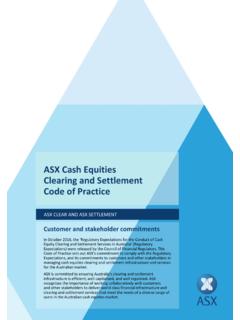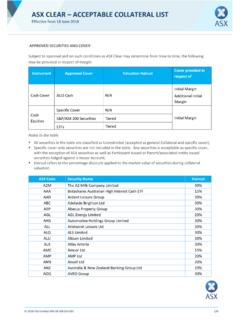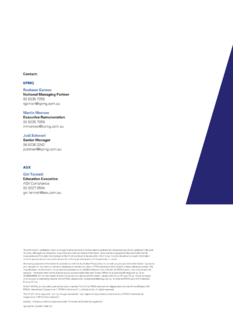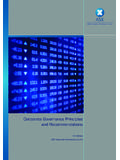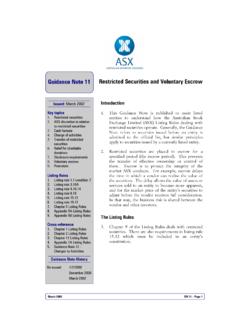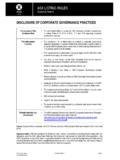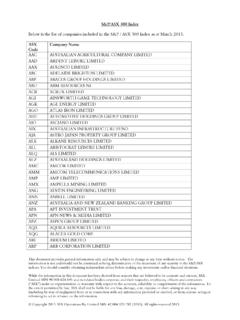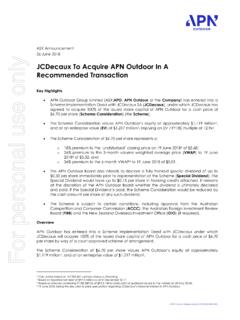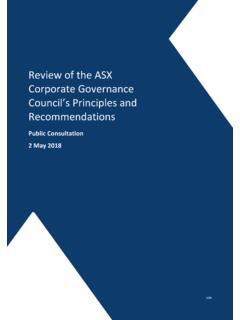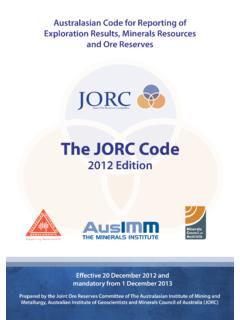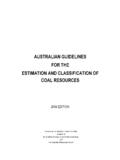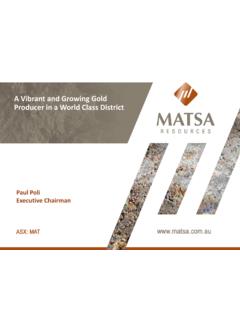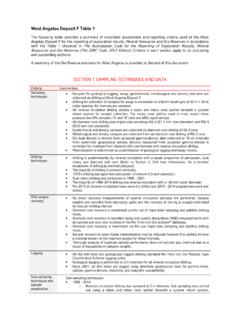Transcription of Changed compliance requirements in the 2012 JORC Code
1 Changed compliance requirements in the 2012 jorc CodeSteve HuntDeputy Chair JORCA pril 2013 IntroductionWhy are there so many changes between the 2004 code and the 2012 code ?A little background: A number of ASX Companies Updates had been issued between 2005 and 2008related to jorc code matters. In October 2011, the jorc Committee released an Issues Paper to stimulatediscussion and comment on how the jorc code could be improved. The Issues Paper attracted 114 written submissions, as well as significantadditional feedback received through public forums and meetings. Comments on the Issues Paper confirmed strong support for the jorc code to remain a principles based professional code .
2 Comments also highlighted there was a need for improved disclosure standards, and a greater balance between the core principles of Transparency, Materiality, and Competence in Public Reporting. Evaluation of the responses enabled jorc to prepare an Exposure Draft of the 2012 jorc code which was released for public comment in September 2012 . In addition to many comments made in consultation forums and meetings, jorc received 82 written submissions in response to the Exposure code Principles basedTransparencyclear unambiguous presentationMaterialityall reasonable informationexpectedCompetenceBased on work by Competent PersonJORCC ompliant ReportsThe principles in Clause 4, 2004 jorc code are:2004 jorc code Principles Competence Bias?
3 A common distortion of the application of the Principles from Clause 4, 2004 jorc code had been noticed resulting in:Transparencyunclear un ambiguous presentationMaterialityselectedreasonabl e informationexpectedCompetenceBased on work by Competent PersonJORCC ompliant Reports? Changed compliance requirements for the 2012 code The requirement, when reportinginitial or materially changedExploration Results or estimates of Mineral Resources and OreReserves for significant projects, to report against Table 1 on an ifnot, why not basis Clauses 2, 5, 19, 27, 35, and the introduction toTable 1. Competent Person attributions Clause 9. Exploration Target now defined in the revised Clause 17.
4 At least a Pre Feasibility Study required for an Ore Reservedeclaration Clause 29. Technical studies definitions Clauses 37, 38, 39, and 40. Metal equivalents Clause 50. In situor in ground values Clause 51. Additional guidance on reporting requirements for CompetentPersons Table 1 body of 2 2004 code 2. In this edition of the jorc code , important terms and theirdefinitions are highlighted inboldtext. The guidelines are placedafter the respective code clauses usingindented italics. They areintended to provide assistance and guidance to readers. They donot form part of the code , but should be considered persuasivewhen interpreting the code .
5 Indented italics are also used forAppendix 1 Generic Terms and Equivalents and Table 1 CheckList of Assessment and Reporting Criteria to make it clear thatthey are alsopart of the guidelines, and that the latter is notmandatory for reporting purposes. This statement (in red above), together with all of the examplesbeing negative, was taken by many Competent Persons as anopportunity not to report all material 2 2012 code 2. In this edition of the jorc code , important terms andtheir definitions are highlighted in bold text. The guidelinesare placed after the respective code Clauses using ,butareintendedto provide assistance and guidance to readers and should beconsidered persuasive when interpreting the code .
6 Indented italics are also used for Appendix 1 GenericTerms and Equivalents and Table 1 Check List ofAssessment and Reporting Criteria to make it clear that theyare also part of the guidelines, and that the latter is notmandatory for reporting guidance on the importance of material informationis now included in Clauses 5, 19, 27, 35, and the introductionto Table 4 2012 code Additional Explanation of Principles Transparency and Materiality are guiding principles of the code ,and the Competent Person must provide explanatory commentaryon the material assumptions underlying the declaration ofExploration Results, Mineral Resources or Ore particular, they must consider that the benchmark of Materialityis that which includes all aspects relating to the ExplorationResults, Mineral Resources or Ore Reserves that an investor ortheir advisers would reasonably expect to see explicit comment onfrom the Competent Person.
7 The Competent Person must notremain silent on any material aspect for which the presence orabsence of comment could affect the public perception or value ofthe mineral occurrence. This slide contains extracts only of Clause 4, 2012 jorc CodeClause 5 2012 code Expands on Reporting Principles Table 1 provides a checklist or reference of criteria to be considered bythe Competent Person in developing their documentation and inpreparing the Public the context of complying with the principles of the code , commentsrelating to the items in the relevant sections of Table 1 should be providedon an if not, why not basiswithin the Competent Person sdocumentation.
8 Additionally comments related to the relevant sectionsof Table 1 must be complied with on an if not, why not basiswithinPublic Reportingfor significant projects (see Appendix 1 Generic Termsand Equivalents) when reporting Exploration Results, Mineral Resourcesor Ore Reserves for the first time. Table 1 also applies in instances wherethese items have materially Changed from when they were last PubliclyReported. Reporting on an if not, why not basis is to ensure that it isclear to an investor whether items have been considered and deemed oflow consequence or are not yet addressed or resolved. This slide contains extracts only of Clause 5, 2012 jorc Code2012 code Introduction of Some New Terms Significant project: An exploration or mineral development projectthat has or could have a significant influence on the market value oroperations of the listed company, and/or has specific prominence inPublic Reports and announcements.
9 (Appendix 1, equivalent to ASXmaterial project). Material change: Amaterialchangecouldbeachangeintheestima ted tonnage or grade or in the classification of the MineralResources or Ore Reserves. Whether there has been a material changein relation to a significant project must be considered by taking intoaccount all of the relevant circumstances, including the style ofmineralisation. This includes considering whether the change inestimates is likely to have a material effect on the price or value of thecompany s securities. (Guideline to Clause 5). if not, why not : means that each item listed in the relevant sectionof Table 1 must be discussed and if it is not discussed then theCompetent Person must explain why it has been omitted from thedocumentation.
10 (Guideline to Clause 5).Clause 19 2012 code Additional requirements for Exploration ResultsGreater clarity on what information related to Exploration Resultsis required to be reported along with if not, why not reportingagainst the relevant criteria in Table significant projects the reporting of all criteria in sections 1 and 2of Table 1 on an if not, why not basis is is preferably as an appendix to the Public disclosure is particularly important where inadequate oruncertain data affect the reliability of, or confidence in, a statementof Exploration Results; for example, poor sample recovery, poorrepeatabilityofassayorlaboratoryresu lts, slide contains information extracted from Clause 19, 2012 jorc CodeClause 27 2012 code Additional requirements for Mineral ResourcesIn Public Reports of Mineral Resources for a significantproject for the first time, or when those estimates havematerially Changed (including classification changes) fromwhen they were last reported, a brief summary of theinformation for all relevant criteria in Table 1 on an if not,why not basis is required.
